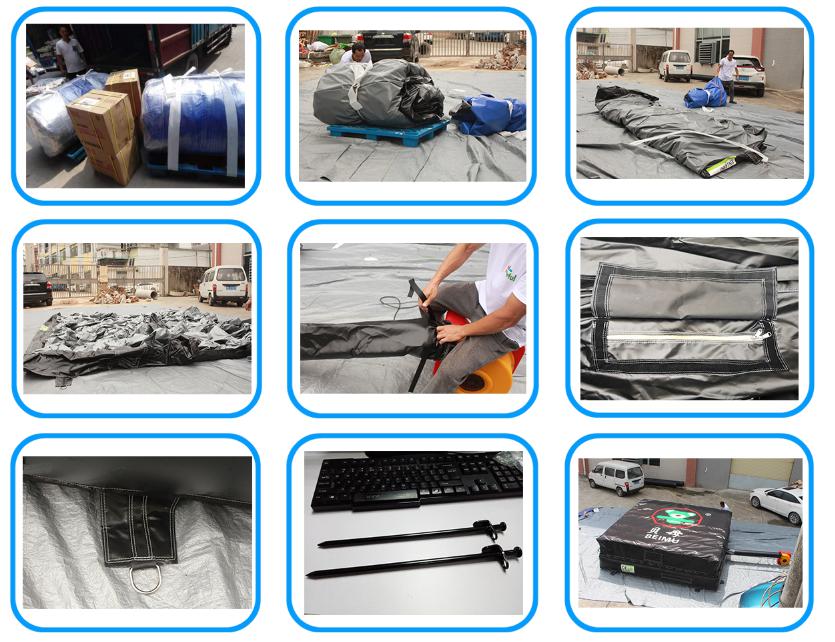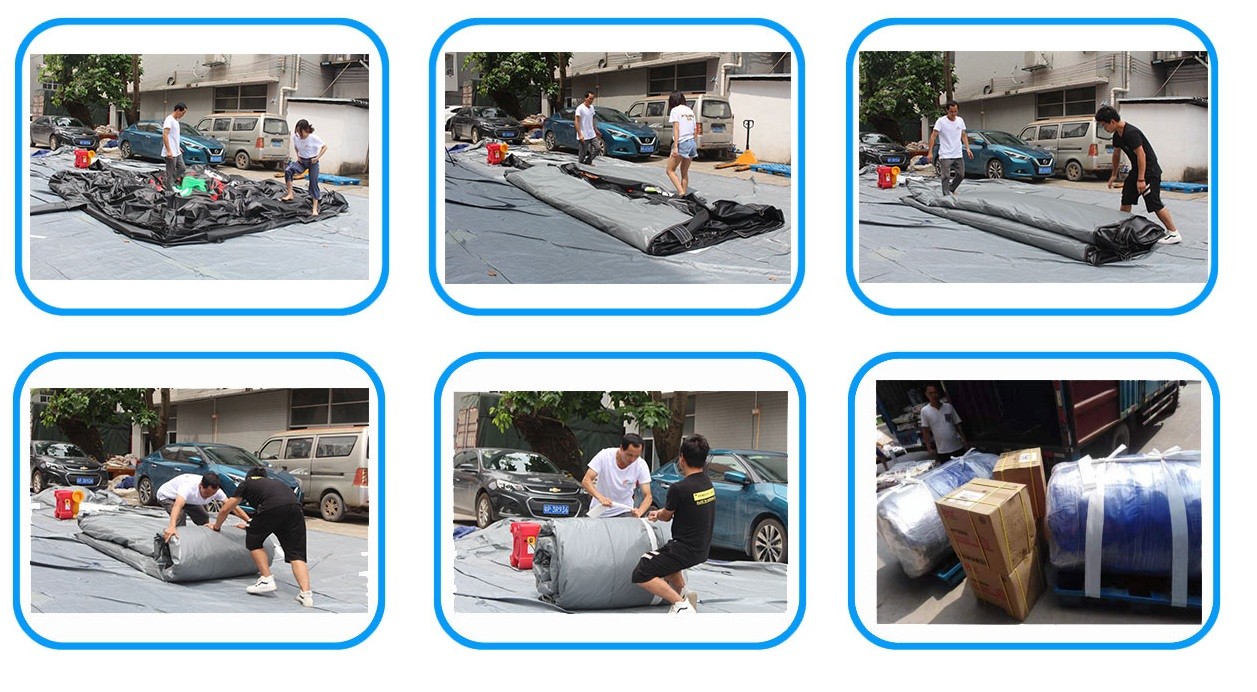
The inflatable can be heavy and care needs to be taken when transporting, unrolling, inflating, adjusting position and securing to the surface. It is important to have enough people participating and sharing the load in these operations to avoid injury or strain to the helpers.
The inflatable comes with two straps and after moving it to the desired location, it should be placed still rolled up at the rear of the site and both straps opened so the unit rolls out towards the front of the site.
Connection tube and blower are firmly attached to each other. Make sure all deflation outlets and zippers are securely closed.
If the inflatable is being used outdoors and there is even a slight breeze, at least one anchor points should be secured before inflation. As soon as the unit is fully inflated you should check that anchor point to see if it needs to be moved. As soon as you are happy with the position of the unit all other anchor points should be secured, either with ground fixing pegs or weight bags.
Ground fixing pegs should be inclined away from the inflatable at 30 to 40 degrees and no more than 25mm or 1 inch should protrude over the ground.
As soon as the unit is fully inflated, routine inspection shall be carried out before use and each time the equipment is made of available for use. The check shold include:
a) Site is suitable
b) All anchorages are secure an in place.
c) Ancillary equipment is in position.
d) There are no significant holes or rips in the fabric or seams.
e) Correct blower is being used.
f) There are no exposed electrical parts and no wear on cables.
g) Plugs, sockets, switches etc are not damaged.
h) Connection tube and bolower are firmly attached to each other.
i) Blower is safely positioned and its mesh guards are intact.
The equipment shall not be used by user or the public until any defects indentified in the routing inspection have been rectified.

Before deflating the inflatable make sure all users are off and well clear of the unit.
Unplug the power and disconnect the tube from the fan and open any zips or deflation tubes all the while leaving the anchor points still fastened. It is best to wait 5 or 10 minutes or longer depending on the size of the unit for all the air to leave the unit. This time can be shortened by walking up and down on the unit.
When it is completely flat unfasten the anchor points and in the case of ground fixing pegs remove them from the ground. As in the assembly, it is important to have enough people participating and sharing the load in these operations to avoid injury or strain to the helpers.
With the unit lying flat on the ground,pull all the top material inside the base, the base is part that is in contact with the ground when the unit is inflated, all the while walking on it to make it as flat as possible.
When it is as flat and neat as possible at least two people one each end should fold in, along the length, about one third of the width and then walk on this section from the front to the back, then fold the other side in 1/3 as the first side until the unit is about 1/3 of the original flat width.
Then make sure to walk on this again from the front to the back starting with a very tight fold at the start as this will result in a compact roll. Having a helper to walk onthe inflatable in front of the two people rolling will be help greatly. Getting the unit as tight as possible is always best as a floppy roll is much harder to handle.
As you come to the end of the roll using a minimum of people, stand the unit up and move with aid of a small hand truck.
The unit can be moved using the hand truck or tumbled. When transferring the unit to vehicle or trailer the unit should be tumbled. At no time should the controller or operator attempt to lift the inflatable off the ground.
The inflatable should be properly maintained and cleaned after each use for hygiene reasons.
Regular Maintenance:
After each use remove any debris from the inflatable.
Wipe clean with a suitable cloth of it the unit is particularly dirty use a mop.
Leave the unit to dry for as long as possible. If the unit must be rolled up wet for transport, re-inflate as soon as possible. It is important not to store your inflatable wet for more than ten days to avoid mildew.
Routine Maintenance:
Depending on how frequently the inflatable is used,routine maintenance should be carried out.
Remove any debris from the inside of the inflatable
Clean the PVC of the inflatable with a non-abravise antibacterial cleaner. Use a sponge and dry off with a towel.
If the inflatable is particularly wet, inflate and leave to dry thoroughly before packing it away.
Any repairs or replacement of worn or defective parts should be addressed and completed before next use.
Fans shold be checked for rust and the blower intake should be cleaned. This can be done with a vacuum.

